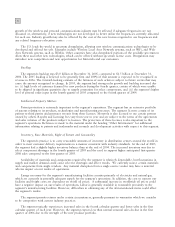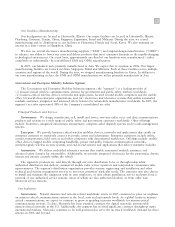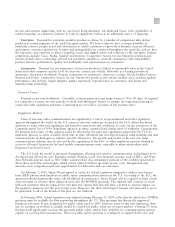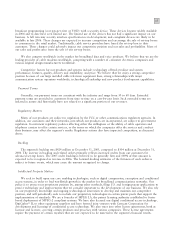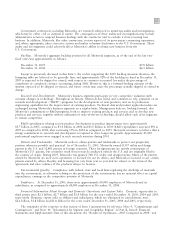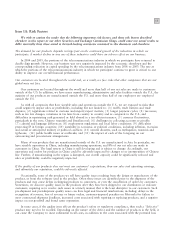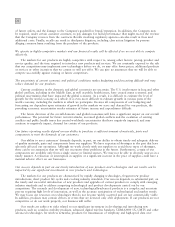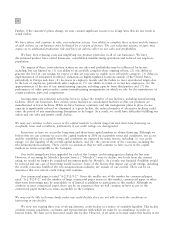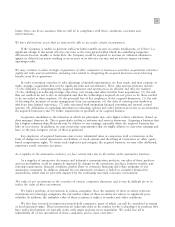Motorola 2005 Annual Report Download - page 21
Download and view the complete annual report
Please find page 21 of the 2005 Motorola annual report below. You can navigate through the pages in the report by either clicking on the pages listed below, or by using the keyword search tool below to find specific information within the annual report.
14
The segment is capitalizing upon the introduction of video services by telecommunication operators to their
subscribers (""Telco TV'' or ""IPTV'') with products that support delivery of video content using both copper-
outside-plant and fiber-to-the-premises networks. During the year, the segment provided end-to-end equipment for
the launch of Verizon's FiOS service and won a contract to supply advanced IP interactive set-top boxes to AT&T.
We are focused on enhancing and expanding our voice and data offerings to offer end-to-end solutions for
fixed-mobile convergence and next-generation converged IP based voice, data and video delivery. These solutions
include: (i) stand-alone and integrated voice/data/WiFi gateways with support for handing off a mobile voice or
data call to a WiFi access point and a carrier's VoIP network, and (ii) next-generation infrastructure products in
the CMTS and fiber optic network markets which expand the bandwidth delivered to a home or business. Sales of
our CMTS infrastructure products increased over 20% in 2005 as cable operators built out their networks to
accommodate high-availability VoIP, higher speed data offerings and multimedia applications such as streaming
video and music as well as interactive gaming. Our voice gateway business experienced significant growth in 2005 as
cable television operators, as well as non-facilities based VoIP service providers, aggressively launched and expanded
their services. We expect this trend to continue in 2006 as the rich capabilities and value of these services result in
continued adoption by mainstream consumers.
Customers
The vast majority of our sales are in the U.S., where a small number of large cable television multiple system
operators (""MSOs'') own a large portion of the cable systems and account for a significant portion of the total
capital spending in the industry. We are dependent upon a small number of customers for a significant portion of
our sales. Comcast Corporation accounted for approximately 31% of the segment's net sales in 2005. The loss of
business in the future from Comcast or any of the other major MSOs could have a material adverse effect on the
segment's business. Sales of video headend equipment and set-top boxes to telephone carriers accounted for
approximately 5% of our revenue in 2005. The opportunity in this market segment is expected to continue to grow
as carriers around the world expand to offer video services.
Competition
The businesses in which we operate are highly competitive. The rapid technological changes occurring in each
of the markets in which we compete are expected to lead to the entry of many new competitors.
We compete worldwide in the market for digital set-top boxes for broadband and satellite networks. Based on
2005 annual sales, we believe we are the leading provider of digital cable set-top boxes in North America. Our
digital cable set-top boxes compete with products from a number of different companies, including: (i) those that
develop and sell substitute products that are distributed by direct broadcast satellite (""DBS'') service providers
through retail channels, (ii) those that develop, manufacture and sell products of their own design, and (iii) those
that license technology from us or other competitors. In North America, our largest competitor is Scientific-Atlanta.
Other competitors in North America include Cisco, ARRIS and C-COR. Outside of North America, where we have
a smaller market position, we compete with many equipment suppliers, including several consumer electronics
companies. Cisco, a major competitor to the segment's IP products, home gateways and systems, announced that it
will acquire Scientific-Atlanta, our largest competitor in conventional hybrid fiber coaxial cable technology. This
combination strengthens Cisco, enabling it to offer end-to-end solutions in both hybrid fiber coaxial cable and IP
networks, and encompasses a broad set of customer relationships around the world.
The traditional competitive environment in the North American cable market continues to change for several
reasons. Based on our customers' requirements, we have begun and will continue to license certain of our
technology to certain competitors. In 2005, we formed a joint venture with Comcast Corporation. This joint
venture licenses certain of our technologies to competitors to build set-top boxes and elements of headend
equipment. Comcast and other network operators can then purchase these products from these licensees.
Historically, reception of digital television programming from the cable broadband network required a set-top
box with security technology that was compatible with the network. This security technology has limited the
availability of set-top boxes to those manufactured by a few cable network manufacturers, including Motorola. The
FCC has enacted regulations requiring separation of security functionality from set-top boxes by July 1, 2007. To
meet this requirement, we have developed security modules for sale to cable operators for use with our own and
third-party set-top boxes. As a step towards this implementation, in 2002, the cable industry and consumer
electronic manufacturers agreed to a uni-directional security interface that allows third-party devices to access


